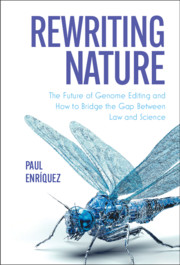Book contents
- Rewriting Nature
- Rewriting Nature
- Copyright page
- Dedication
- Summary of Contents
- Contents
- Figures
- Foreword
- Acknowledgments
- Table of Cases
- Abbreviations
- 1 A Momentous Time for Humankind
- 2 How an Idea Became a Reality
- 3 What Is Genome Editing?
- 4 Molecular Paraphernalia
- 5 What Can Genome Editing Be Used for?
- 6 Redesigning Food
- 7 Regulating Bioengineered Food
- 8 Redesigning Humanity
- 9 DNA and the Administrative State
- 10 Constitutional Predicaments
- 11 Science, Law, and Policy
- 12 Epilogue
- Index
8 - Redesigning Humanity
Published online by Cambridge University Press: 11 June 2021
- Rewriting Nature
- Rewriting Nature
- Copyright page
- Dedication
- Summary of Contents
- Contents
- Figures
- Foreword
- Acknowledgments
- Table of Cases
- Abbreviations
- 1 A Momentous Time for Humankind
- 2 How an Idea Became a Reality
- 3 What Is Genome Editing?
- 4 Molecular Paraphernalia
- 5 What Can Genome Editing Be Used for?
- 6 Redesigning Food
- 7 Regulating Bioengineered Food
- 8 Redesigning Humanity
- 9 DNA and the Administrative State
- 10 Constitutional Predicaments
- 11 Science, Law, and Policy
- 12 Epilogue
- Index
Summary
A new age began in November 2018, when the world learned shocking news about the birth of the first gene-edited babies in China. He Jiankui, an unseasoned researcher who performed haphazard and surreptitious experiments on viable human embryos using CRISPR–Cas9, confirmed he had manipulated the CCR5gene, which plays a role in HIV resistance in humans. Calls for bans on such uses of genome-editing technology surfaced immediately. Some critics claim that editing the human germline (a term that refers to sperm, eggs, zygotes, and embryos) is immoral, unethical, and will push society down a dangerous eugenic path. A common concern is that genome-editing technologies are inherently insidious because they will lead to “designer babies” with a panoply of artificial traits, including superior intelligence, athleticism, or even beauty. Uncertainty in this emerging field of law and science is further compounded by the lack of scientific knowledge among the general public and the dearth of international norms in an increasingly globalized world. This chapter dives into the myth of designer babies and explores the dissonance between public opinion and the science of complex human traits. In so doing, it grounds the conversations on scientific facts to elucidate whether intelligence and other complex traits can really be engineered in a test tube.
Keywords
- Type
- Chapter
- Information
- Rewriting NatureThe Future of Genome Editing and How to Bridge the Gap Between Law and Science, pp. 264 - 286Publisher: Cambridge University PressPrint publication year: 2021

